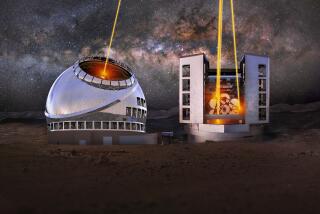Clinton Says Robots Will Explore Mars
- Share via
WASHINGTON — Reversing a plan to send astronauts to Mars, the White House said Thursday that surface exploration of the planet will be done by robots, including one scheduled to land there July 4.
President Clinton, who discussed the revised policy while campaigning for reelection in Tacoma, Wash., alluded, tongue in cheek, to the science-fiction movie thriller “Independence Day,” in which space aliens attack the Earth. “We thought we’d go visit them first and try to get around that blowing up the Capitol and the White House business,” he said.
The announcement came on the day that the space shuttle Atlantis retrieved American astronaut Shannon Lucid after her record-breaking stay aboard the Russian space station Mir.
Lucid, saying “it’s good to be back” on a U.S. spacecraft, eagerly carried her bags from the orbiting Russian station to Atlantis for her ride home. She has now been in space 181 days, longer than any other woman or any other American astronaut. She is scheduled to return to Earth next Thursday.
Clinton hailed Lucid as “our American hero” as he announced the results of the first major review of American space policy since the end of the Cold War.
“We are going to continue to expand our knowledge of the universe,” Clinton said.
But the bulk of the exploring of the high frontier will be done by robots, cameras and scientific instruments--not humans.
Then-President Bush had said in 1989 that the United States would land an astronaut on Mars, but the plan never got off the ground. His administration had envisioned establishing a colony on the moon, then sending human expeditions to Mars.
The White House study released Thursday concluded that the goal of sending a manned mission to Mars by the year 2019 was too costly and too risky. Instead, it committed the government’s National Aeronautics and Space Administration to “the sustained robotic exploration of Mars,” a policy that the agency already has been pursuing.
In fact, one of the robots--the Mars Pathfinder--is scheduled for launch on Dec. 2 and a landing on the Red Planet on July 4. The Martian lander would deploy a small instrumented vehicle, called a rover, to investigate the nearby terrain--the elements in its rocks and soil. It also would sample the atmosphere and surface weather.
Another unmanned probe--the Mars Global Surveyor--is to be thrust into Mars orbit later this year to send back scientific data and high-resolution photographs of the planet.
NASA envisions sending robots every 26 months when launch times are most opportune.
Clinton said that the results of the unmanned missions would determine whether to pursue the dream of landing American astronauts on Mars.
White House science advisor John H. Gibbons said that the robotic missions would be dispatched not only to Mars but to other planets and celestial bodies. “This will take us to a new level of exploration, from long-distance observation to close-up examination and touching,” said Gibbons.
Gibbons referred to last month’s discovery of the possibility of ancient life forms on Mars and said that the United States would lead the way toward unlocking the secrets of the solar system.
“While much remains to be done to conclusively prove the recent Mars findings, I think everyone in the scientific community agrees on one thing: We want to know more and to know more we must go further in our exploration efforts beyond Earth.”
Wesley Huntress, NASA’s associate administrator for space science, said that the new plan for exploring Mars “is not the result of the Martian rock” discovery, which she referred to as “that delightful but strictly fortuitous find.”
Alan Ladwig, NASA’s associate administrator for policy and plans, said that Clinton’s announcement “supports the track NASA has been on.” The small robotic missions proclaimed by Clinton have been in the planning and building stages for years.
The plan to put humans on Mars early in the 21st century was announced by Bush amid the celebrations of the 20th anniversary of the first U.S. moon landing. But the ambitious scheme stalled in large part because of the estimated $500-billion price tag.
Since then, NASA has struggled to maintain its budgets and justify its mission in an era of constrained resources. Shuttle flights have become less frequent and are often shared with other nations and commercial enterprises.
The new policy, for which no cost estimates were released, calls for cutting space program costs by buying more hardware and services from the private sector and sharing a number of activities, like satellite launches, with other nations.
The new policy reconfirmed the U.S. commitment to the international space station project. The U.S. hopes to begin construction of an orbiting permanent research facility by the end of the century.
The policy directive signed by Clinton on Thursday also ordered the Defense Department, the Central Intelligence Agency and other intelligence units to work together more closely on space-related activities.
The document identified the nation’s military space priorities as supporting military operations, monitoring strategic threats and assuring compliance with arms-control treaties.
Clinton plans to convene a White House summit on the future of the U.S. space program in December. Thursday’s report will be the starting point for those discussions, aides said.
More to Read
Sign up for Essential California
The most important California stories and recommendations in your inbox every morning.
You may occasionally receive promotional content from the Los Angeles Times.










